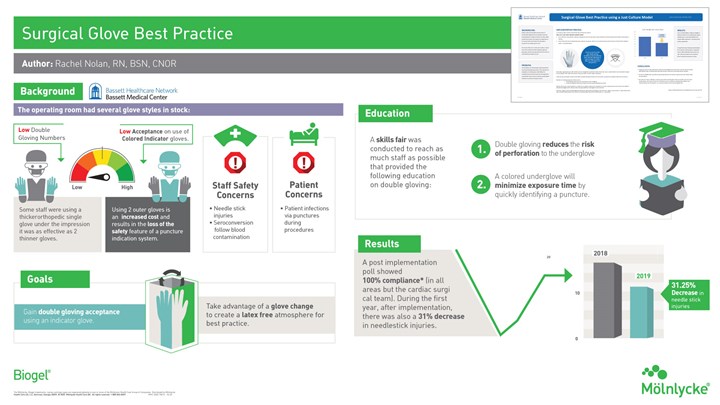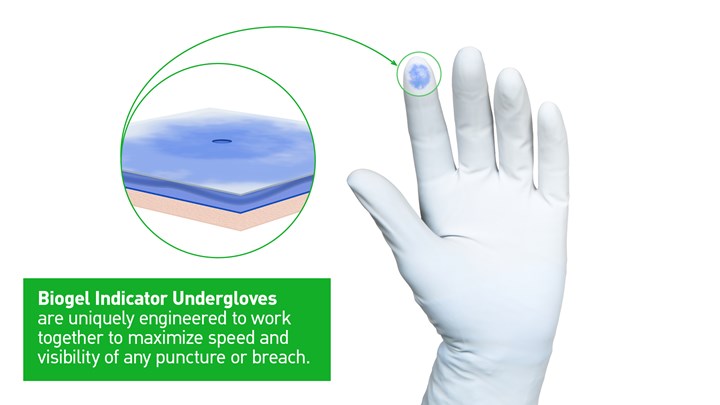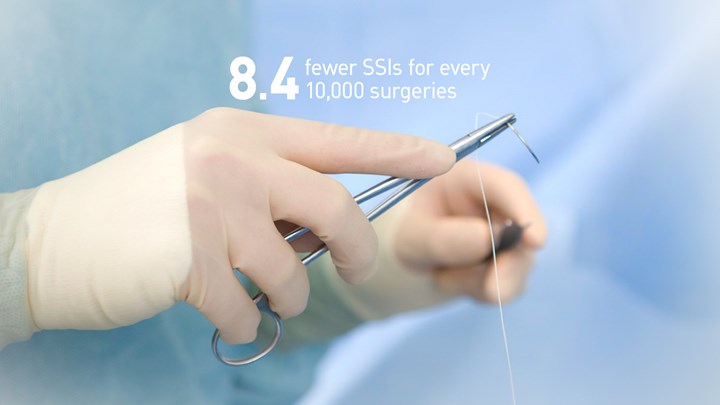
The operating room at Bassett Medical Center conducted a skills fair and 2 week surgical glove trial to gain double gloving acceptance using a colored indicator glove, create a synthetic (no natural rubber latex) atmosphere and lower SKUs. Staff chose Biogel as the new glove.
Post implementation showed 100% double gloving compliance in all areas but the cardiac surgical team. There was a 31% decrease in needlestick injuries during the first year following implementation. The OR consolidated SKUs, projected an approximate $43,000 cost reduction in glove spend and clinically benefitted from a no natural rubber latex atmosphere.
Biogel® Surgical Gloves Reduce the Risk of Surgical Site Infections
Higher Risk of SSIs With Glove Perforations
Glove perforation causes a break in aseptic technique and germs can be transferred from surgical staff to the patient and vice versa, increasing the risk of SSI’s to 6.9%.

Maximize speed and visibility of any puncture or breach.
✔Clear - Blue inner glove color was selected based on color physics to maximize visibility.
✔Fast - Designed to make the spot following a puncture visible as fast as possible.
✔Large - Indication size is designed to provide a large, visual alert from a distance.

Clinical Study
The clinical consequences of glove perforations during surgery as determined by the incidence of SSIs.
The transfer of pathogens during surgery is frequently caused via skin or blood contact between surgical staff and patients, specifically, skin-borne pathogens on staff hands are particularly susceptible to transfer. There is also an infection risk from blood-borne diseases (such as HIV, viral Hepatitis B, viral Hepatitis C and bacterial pathogens). When gloves are perforated – for example, as a result of puncture by needles, spiked bone fragments, or sharp surfaces on complex instruments– as the barrier breaks down and pathogens are transferred. The risk of glove perforation increases with duration of operating time – significantly so after two hours – and occurs more often when gloves do not fit properly. The frequency of glove perforation during surgery ranges from 8% to 50%.
The Biogel® Puncture Indication® SystemTM can increase breach detection from 10% to 97%.
Biogel Indicator Undergloves
Biogel’s Indicator double-gloving system was the first patented puncture indication system in the world.
Biogel offers both latex and non-latex indicator undergloves that indicate with a variety of Biogel overgloves, allowing you to create your own customized double-gloving system balancing protection and tactile sensitivity.

Double-gloving is proven to reduce risks of sharps injuries and exposure to bloodborne infections by 71%
- On average, only 10% of glove punctures are noticed during surgery putting surgeons, operating staff and patients at risk for cross infection.
- At least 60 different blood-borne pathogens can be transmitted to healthcare workers due to accidental exposures. HIV, Hep B and Hep C account for most of this risk.




